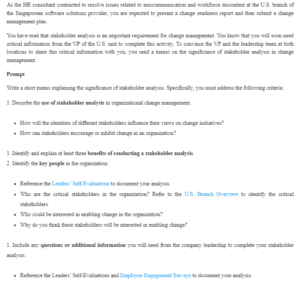Stakeholder Analysis
Stakeholders play a significant role in successful change implementation. As such, we must conduct a detailed stakeholder analysis to identify their needs, predict potential resistance areas, and prepare to address them. Therefore, I am requesting access to critical information that will portray stakeholder needs, opinions, and identities that could influence their views on the proposed change.
Do you need an original copy of the “Stakeholder Analysis” ? Get in touch with us.
The Role of Stakeholder Analysis in Change Management
According to Grau (2021), stakeholders are an organization’s main drivers of change. Therefore, a stakeholder analysis helps to identify the stakeholders’ perspectives and needs to determine how the proposed change will influence them. It also helps to determine the appropriate tactics to communicate the proposed change to stakeholders.
How Identity Influences Views of Change
Stakeholders’ identity defines their needs and expectations, thus influencing their views of change. For example, employees view change based on how it affects their well-being. In contrast, investors view change based on how it affects the organization’s well-being regarding profitability and performance. These identities also affect change acceptance based on whether the change yields the desired outcome.
How Stakeholders Influence Change
Stakeholders may influence the views of change initiatives by supporting or rejecting the change. For instance, when many employees resist a particular change, they create negative opinions on the change initiatives, thus influencing other stakeholders, such as company owners and investors, to reconsider the change to increase acceptance. Stakeholders may also affect their views on change based on their commitment to the change implementation process. Franklin (2021) argues high commitment creates a positive view of the change initiatives and reduces resistance.
Benefits of Stakeholder Analysis
One of the benefits of stakeholder analysis is identifying the needs of stakeholders, thus designing appropriate strategies to meet them. The second benefit is determining the role of stakeholders in the organization and how their involvement can be enhanced to improve organizational performance. The third benefit is uncovering and removing various barriers to achieving the organization’s goals.
Key Stakeholders
The key stakeholders in the organization are employees, customers, and investors.
Critical Stakeholders
Critical stakeholders are the individuals actively creating and implementing organizational strategies, procedures, and proposals (Benn et al., 2016). The vital stakeholders in the U.S. branch include the vice president, who is in charge of leading operations and departments and creating the organization’s overall values, mission, values, strategic goals, and beliefs. The other critical stakeholder is the accounting manager, who is required to manage the accounting functions in the organization to understand how to increase profitability, control transaction processes, evaluate financial processing, and maintain accurate transaction records.
Change Coalition
The customer success manager and sales manager could be interested in enabling change in the organization to facilitate collaboration in strategic planning and proper flow of communication in the implementation of strategic plans. The customer success manager requires feedback from management on the recommended actions to improve service delivery, excellence, and quality, thereby eliminating miscommunication. The sales manager could also be interested in implementing the change to reduce miscommunication because proper communication is necessary for devising engaging campaigns. The sales manager should also be contented with their work to remain committed to increasing brand awareness.
Additional Information Needed
The primary additional information I will need to conduct the stakeholder analysis is the level of participation of each stakeholder in the organization’s decision-making process. This information is essential in identifying potential resistance areas and the impact of stakeholder identities on implementing the proposed change.
Conclusion
Understanding the needs of stakeholders is essential in change implementation because it helps an organization predict resistance and prepare for it. Stakeholder analysis is also necessary for change implementation because it enables an organization to determine the appropriate tactic to communicate the change. Therefore, conducting a detailed stakeholder analysis and applying the findings in decision-making is essential for successful change implementation.
References
Benn, S., Abratt, R., & O’Leary, B. (2016). Defining and identifying stakeholders: Views from management and stakeholders. South African Journal of Business Management, 47(2), 1-11. https://doi.org/10.4102/sajbm.v47i2.55
Franklin, M. (2021). Agile change management: A practical framework for successful change planning and implementation. Kogan Page.
Grau, S. L. (2021). Understanding and engaging with your stakeholders. Marketing for Nonprofit Organizations, 85-108. https://doi.org/10.1093/oso/9780190090807.003.0004
ORDER A PLAGIARISM-FREE PAPER HERE
We’ll write everything from scratch
Question
As the HR consultant contracted to resolve issues related to miscommunication and workforce discontent at the U.S. branch of the Singaporean software solutions provider, you are expected to present a change readiness report and then submit a change management plan.

Stakeholder Analysis
You have read that stakeholder analysis is an essential requirement for change management. You know that you will soon need critical information from the VP of the U.S. unit to complete this activity. To convince the VP and the leadership team at both locations to share this crucial information with you, you send a memo on the significance of stakeholder analysis in change management.
Prompt
Write a short memo explaining the significance of stakeholder analysis. Specifically, it would be best if you addressed the following criteria:
- Describe the use of stakeholder analysis in organizational change management.
-
- How will the identities of different stakeholders influence their views on change initiatives?
- How can stakeholders encourage or inhibit change in an organization?
- Identify and explain at least three benefits of conducting a stakeholder analysis.
- Identify the key people in the organization:
-
- Reference the Leaders’ Self-Evaluations to document your analysis.
- Who are the critical stakeholders in the organization? Refer to the U.S. Branch Overview to identify the essential stakeholders.
- Who could be interested in enabling change in the organization?
- Why do you think these stakeholders will be interested in enabling change?
- Include any questions or additional information you will need from the company leadership to complete your stakeholder analysis.
-
- Reference the Leaders’ Self-Evaluations and Employee Engagement Surveys to document your analysis.

